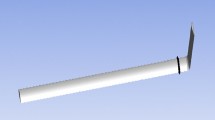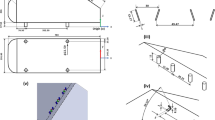Abstract
This paper is devoted to the characterization of an optimized chevron-shaped anti-contamination device (ACD). This device can prevent efficiently the propagation of turbulence from the fuselage along the attachment line (hypothetical streamline that spreads the flow going to suction side and the one going to pressure side) of swept wings and enables the development of a new laminar boundary layer downstream. More specifically, the aim is to prevent boundary-layer transition along the attachment line by a contamination process. This process is characterized by the typical Reynolds number \(\overline{R}\) and the associated Poll’s criterion. Thus, ACD efficiency will be expressed in terms of \(\overline{R}\) values. Some experiments performed on a new numerically optimized ACD have shown its ability to prevent leading-edge contamination up to \(\overline{R}\) values close to the natural transition process of the laminar boundary layer along the attachment line. The corresponding stability analysis of the laminar boundary layer is made using the Görtler–Hämmerlin stability approach. The study is completed with the different transition processes that can occur downstream the attachment line, around the airfoil, especially with crossflow analysis.

















Similar content being viewed by others
References
Arnal D (1996) Control of laminar turbulent transition for skin friction drag reduction. In: Control of flow instabilities and unsteady flows. In: Meier GEA, Schnerr GH (eds) CISM Courses and lectures, vol 369. Springer-Verlag, New York, pp 119–153
Arnal D, Habiballah M, Coustols E (1984) Laminar instability theory and transition criteria in two- and three-dimensional flows. La Recherche Aérospatiale (English Edition), 2nd edn. pp 45–63
Arnal D, Reneaux J, Preist J (1996) Control of attachment line contamination. In: 2nd European forum on laminar flow technology, Bordeaux
Bippes H (1999) Basic experiments on transition in three-dimensional boundary layers dominated by crossflow instability. Prog Aerosp Sci 35(4):363–412. doi:10.1016/S0376-0421(99)00002-0
Gasparian G (1998) Experimental study and transition mechanisms modeling on swept wing, with application to laminar flow control. Ph.D. thesis, ENSAE
Gaster M (1967) On the flow along swept leading edges. Aeronaut Quat 18(2):165–184
Görtler H (1955) Dreidimensionale instabilität der ebenen staupunktströmung gegenüber wirbelartigen störungen. Fifty years of boundary layer research. Vieweg und Sohn, Braunschweig, p 304
Hiemenz K (1911) Die grenzschicht an einem in den gleichförmigen flüssigkeitsstrom eingetauchten geraden kreiszylinder. Dingl. Polytech., Göttingen, Phil. Diss
Krier JV, Sucipto T (2009) Highly optimizable laminar flow control devices. In: 19th AIMETA Congress, Ancona, Italy
Krier JV, Sucipto T, Archambaud JP, Godard JL, Donelli R, Arnal D (2009) Passive and active device for laminar flow control of swept wing. In: Proceedings KATNET II Conference on Key Aerodynamic Technologies. Bremen, Germany
Morkovin M, Reshotko E, Herbert T (1994) Transition in open flow systems - a reassessment. Bull of the Am Phys Soc 39(9):1882–1994
Pfenninger W (1965) Flow phenomena at the leading edge of swept wings. Recent Developments in Boundary Layer Research. AGARDograph 97, Part IV
Poll D (1978) Some aspects of the flow near a swept attachment line with particular reference to boundary layer transition. Tech. rep., College of Aeronautics
Poll D (1985) Boundary layer transition on the windward face of space shuttle during re-entry. AIAA paper 85-0899
Smith A, Gamberoni N (1956) Transition, pressure gradient and stability theory. Technical report ES-26388, Douglas Aircraft Company
von Doenhoff A, Braslow A (1961) Effect of distributed surface roughness on laminar flow. In: Lachmann GV (ed) Boundary layer control, vol 2. Pergamon Press, New-York, pp 657–681
van Driest E, Blumer C (1962) Boundary layer transition at supersonic speeds. Three-dimensional roughness effects (spheres). J Aerosp Sci 29:909–916
van Ingen J (1956) A suggested semi-empirical method for calculation of the boundary layer transition region. University of Technology, Department of Aerodynamics UTH-74, Delft
Acknowledgments
Part of this work has been undertaken within the Joint Technology Initiative «JTI Clean Sky» and specifically in the framework of the Smart Fixed Wing Aircraft Integrated Technology Demonstrator (SFWA-ITD Contract No. CSJU-GAM-SFWA-2008-001) financed by the 7th Framework Program of European Commission. The authors would like to thank the partners of the project for their collaboration and fruitful discussions. The authors are grateful to ONERA/GMT F2 wind tunnel team J.M. Deluc, T. Joret and P. Loiret for their technical support during the experimental campaign in F2 wind tunnel. The authors would also like to warmly thank F. Ternoy and G. Outtier who manufactured the ACD. Special thanks are given to D. Arnal and A. Séraudie who initiated this study and performed the first wind tunnel campaign in 2010 (they well deserved their retirement).
Author information
Authors and Affiliations
Corresponding author
Rights and permissions
About this article
Cite this article
Fiore, M., Vermeersch, O., Forte, M. et al. Characterization of a highly efficient chevron-shaped anti-contamination device. Exp Fluids 57, 59 (2016). https://doi.org/10.1007/s00348-016-2149-1
Received:
Revised:
Accepted:
Published:
DOI: https://doi.org/10.1007/s00348-016-2149-1




